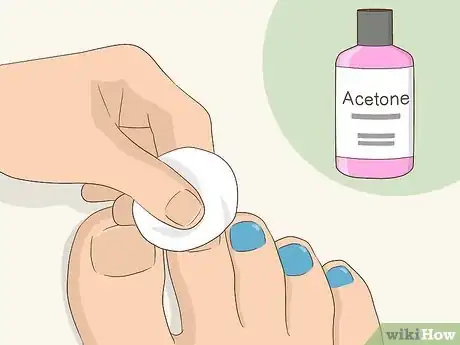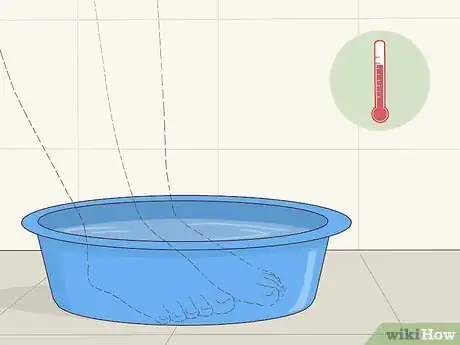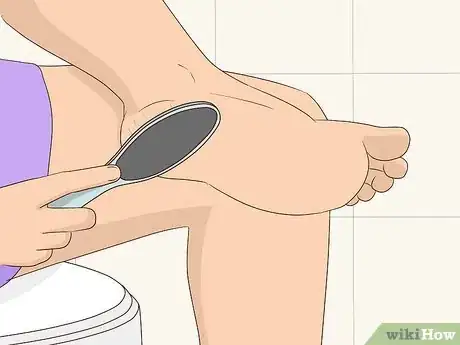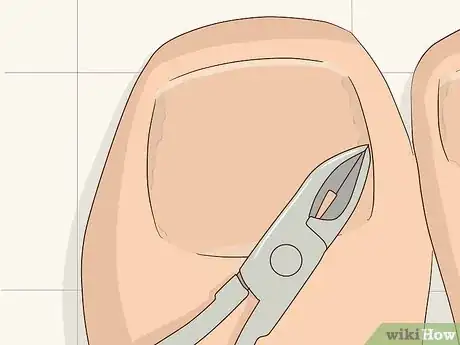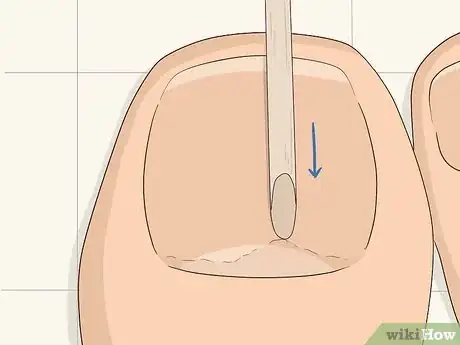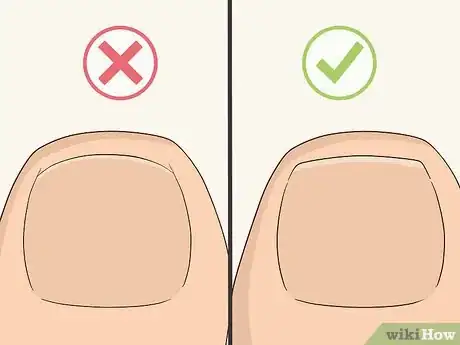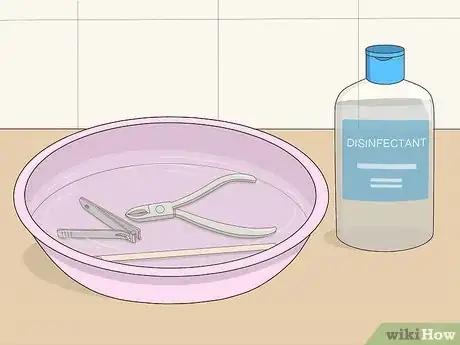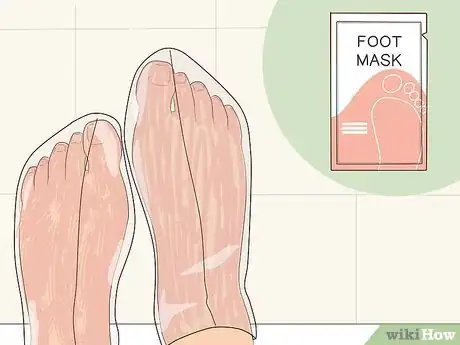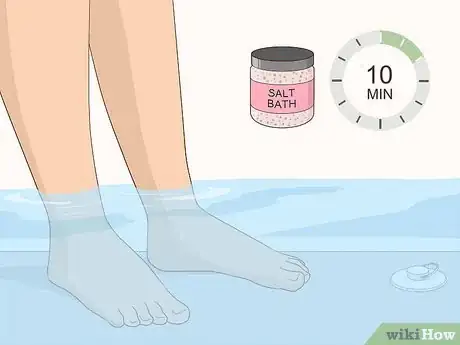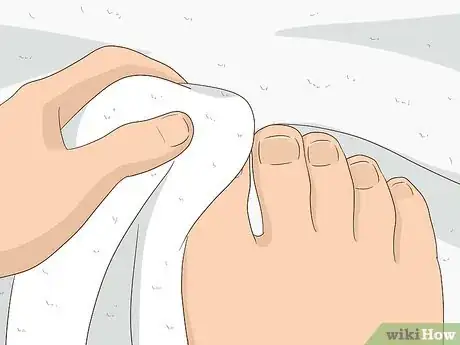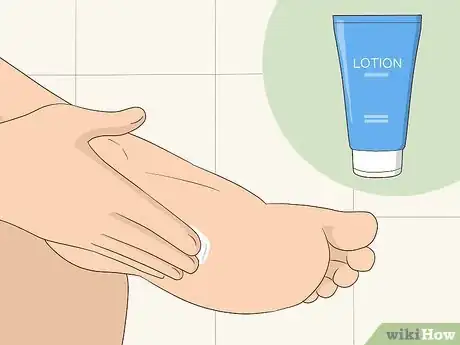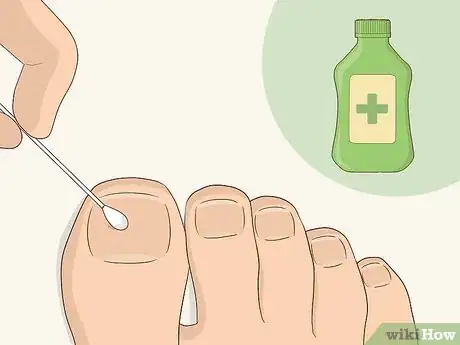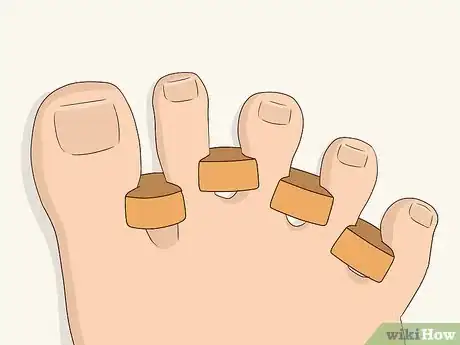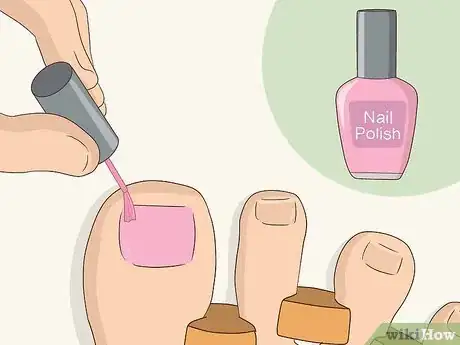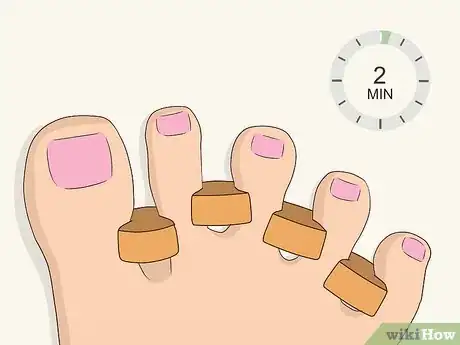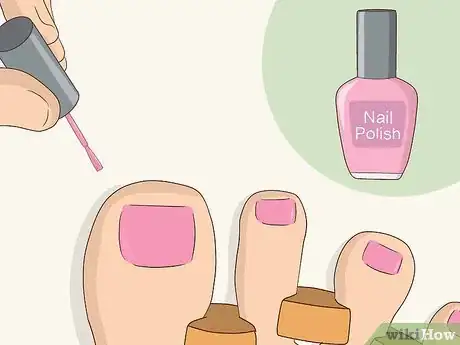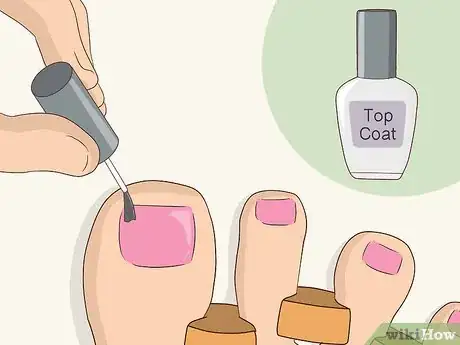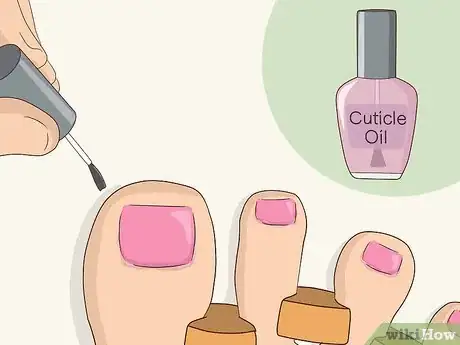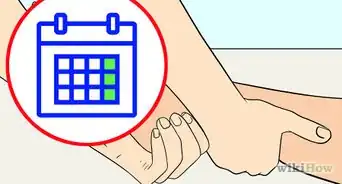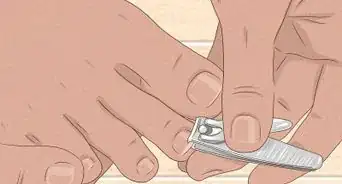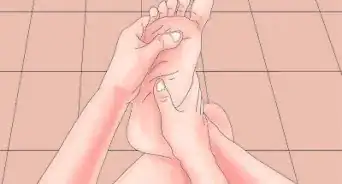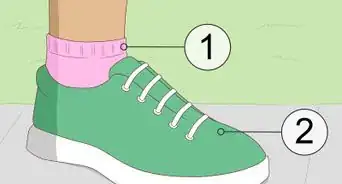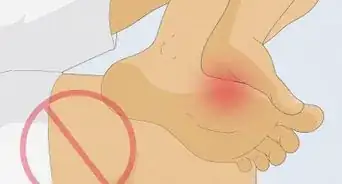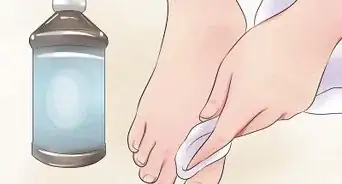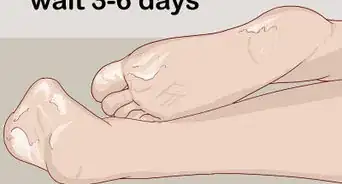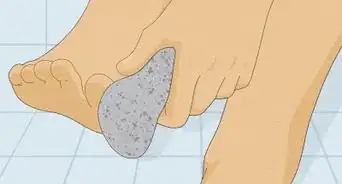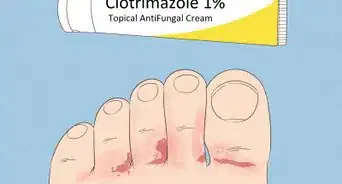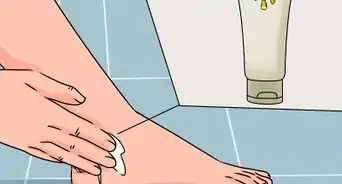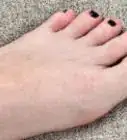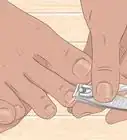This article was co-authored by Kristin Pulaski and by wikiHow staff writer, Janice Tieperman. Kristin Pulaski is a Professional Nail Artist and the Founder of Paintbucket, a self-owned and operated nail salon based in Williamsburg, Brooklyn. She has over five years of experience running Paintbucket and is licensed as a nail technician. Paintbucket offers nail art manicures, pedicures, and soft gel extensions along with customized packages for wedding and bridal parties. She holds a BA in Managerial Science from Manhattan College.
There are 10 references cited in this article, which can be found at the bottom of the page.
This article has been viewed 169,125 times.
Pedicures are a relaxing and rejuvenating way to keep your feet in great shape. While countless salons offer this service, you can save money by giving yourself a pedicure at home. Once you’ve exfoliated away any rough skin and cleaned off the surface of your nails with rubbing alcohol, you’re ready to apply some polish! Start with a clear base coat, followed by 2 layers of colored lacquer. Finish off your salon-quality pedicure with a clear top coat. After letting your polish dry for 1 hour, you’ll be ready to go out and about with refreshed and pampered feet!
Steps
Soaking and Exfoliating Your Feet
-
1Remove old polish. Soak a cotton swab or pad with acetone and begin dabbing it over the surface of your nails. Work on each nail individually, swiping over the surface nail repeatedly until all old polish is removed.[1] If your toenails are bare to start, wipe them down with acetone to remove any excess oil that’s built up on the nail surface.[2]
- If you’d prefer to use a product that doesn’t dry out your skin, try using other vinegar, hydrogen peroxide, or other household products. You can also look for a polish remover without acetone.
- You might have to use more than 1 cotton ball or pad to successfully remove all of the old polish.
-
2Soak your feet in warm water for 10 minutes. First, fill a tub large enough to hold both of your feet with pleasant, warm water. Then, place both of your feet into the tub and make sure they’re submerged completely. Let your feet sit under the water for ten minutes to allow your nails to soften and while you do, enjoy a nice book, magazine, or TV show.
- If you’d like, add a scoop of epsom salt to your basin, stirring until the salt has totally dissolved. This can relieve pain and help you feel even more relaxed.
Advertisement -
3Exfoliate your heels with a large file to remove dead skin. Take a large foot file and rub along the roughest portions of your skin in short, quick motions. Spend extra time on the heels and balls of your feet, and any other place where rough skin cracks occur. Only file 1 foot at a time—feel free to leave your other foot in the soaking basin while you work.[3]
- Be patient as you file away at the rough skin. While it may seem more time-consuming, try working on your feet in slow, buffing motions.
- Check your local beauty store for other filing tools. Some brands make filing equipment specifically for pedicures.
- A pumice stone is a great way to keep your feet smooth after the pedicure.[4]
Trimming and Grooming Your Toenails
-
1Clip away any dead skin around your toenails. Examine your feet to see if your nails are digging into the skin below. Use a pair of nail clippers to pry off any pieces of overgrown nails and dead skin, which can interfere with your pedicure in the future. Work gently as you remove any large and unwanted pieces of dead skin around the nail.[5]
- Make sure that the skin you’re trimming away is dead, and not healthy skin that’s still connected to the toe.
-
2Push back your cuticles with an orange stick if they’re too high up. Avoid cutting or trimming your cuticles, as this can invite loads of bad bacteria into your nails.[6] Instead, use an orange stick to nudge your cuticles backwards, forcing them against the base of the nail.[7]
- Only push back your cuticles after your feet are soaked and the skin is softened.
-
3Clip your toenails in a straight line. Use a sanitized pair of clippers to trim your nails in a straight, even line. Don’t cut around the corners, or try to shape your nails into a curve, as this can create ingrown nails later on.[8]
- Polish is less likely to chip from nails that are trimmed in a straight line.
-
4Wipe off or soak your tools in a disinfectant before storing them. Use disinfectant wipes or a disinfectant solution to clean off your nail clippers, orange stick, and other reusable pedicure tools. Check that the solution kills most common bacteria, including athlete’s foot and staph. Read the label on the disinfectant to see how long it takes for your equipment to be sterilized, and wait for that amount of time.[9]
- Rubbing alcohol works fine as a disinfectant.
- Always sterilize your nail equipment after using it.
Moisturizing Your Feet
-
1Apply a foot mask to soothe and moisturize your feet. Look at your local beauty or drug store to find a foot mask. If your feet are dry, invest in a moisturizing product; if your skin is thick and covered with callouses, opt for peeling mask treatment instead. Rub the product in a thin layer all over your skin, then prop your feet up on a flat surface, like the edge of a bathtub. Keep the mask on for the time recommended by the product’s label.[10]
Tip: If you’re worried that your skin might be sensitive to the foot mask, test a small amount of the product on a small area of your foot ahead of time to ensure that you aren’t sensitive or allergic to the ingredients.
-
2Rinse the mask off your feet by soaking them in the salt bath for 10 minutes. Place both feet in the basin to remove the thin layer of mask product. Swirl your feet around in the tub, letting the salt soak rinse the mask away. During this time, feel free to sit back with a book, magazine, or some other relaxing activity.
-
3Dry off your feet with a clean towel. Remove both feet from the salt soak and surround them with a clean, fluffy towel. Next, focus on blotting away any water dripping from your feet. Continue towel drying, working the towel in between your toes to get rid of any excess moisture. You can set the towel aside once your feet feel dry to the touch.[11]
- If you don’t have a towel on hand, feel free to use a wash rag or paper towel instead.
-
4Rub lotion around your feet and toes to lock in moisture. Take a coin-sized amount of moisturizing lotion and rub into your fingertips. Use your fingers to massage the lotion all over your feet, working over the top and bottom of each foot. Continue working the lotion between your toes, and on the base of your nails.[12]
- For a full pedicure experience, rub lotion over your ankles and lower calves as well.
- Use a lotion that works best for your skin type. For instance, if your feet are especially dry, look for a lotion that’s moisturizing.
Applying Nail Polish
-
1Clean off the nail surface with a Q-tip dipped in rubbing alcohol. Soak the tip of a cotton swab in rubbing alcohol, then rub it along the surface of each individual toenail. Don’t worry about scrubbing the nail—just focus on cleaning off any excess oils or product that may have stuck to the nail during the bath soak. Wait a minute or so for the alcohol to dry off before you continue.[13]
-
2Place a separator tool between your toes. Take each individual toe and rest it in a single groove of the toe separator. If you aren’t experienced with applying toenail polish, use this tool to keep your toes apart while you apply the clear and colored lacquer.[14]
- If you’re experienced with nail polish, feel free to disregard this.
-
3Spread a layer of clear base coat over your toenails. Take the polish applicator and rub a strengthening layer of base coat on each individual nail. Start on your big toe and work outwards, painting in the same order that you plan to paint your toes. Wait 3-5 minutes for the base coat to dry, or however much time is specified on the bottle.[15]
- Base coats prevent the polish from staining your base nail later on.
- If you prefer to use dark nail polish shades, base coats can keep your nails from looking yellowed.
- While you’re shopping at your local beauty supply shop or drugstore, look for a base coat formula that’s labeled as moisturizing.
-
4Paint on 1 coat of colored polish over the base coat. Dip the polish brush into the bottle slightly, then place the brush in the center of your nail. Let the polish pool over the surface of the nail, then use the brush to nudge the polish to the left and right.[16] Don’t excessively brush over the product, as this can make your polish look bumpy and unprofessional.[17]
- Ideally, you only need to use 3 swipes of your polish brush to apply a single coat of polish.
-
5Wait 2 minutes for the first layer of polish to dry. Let the base color layer dry before you add a second layer. Don’t wave your toes around to speed up the drying process, as this can cause the wet polish to smudge or warp. Instead, leave your toes flat, so the polish can dry evenly.[18]
- While it may be tempting to only apply 1 coat of colored polish, the second coat can make the color of your pedicure look bolder and more striking.[19]
-
6Add a second coat of colored polish to your toenails and let it dry. Take your applicator and spread on another layer of the same colored lacquer. Work the polish over the nail in 3 strokes again, letting the product naturally spread over each nail. Once you’ve applied the second coat, rest your feet on a flat surface and wait at least 2 minutes for the polish to dry.[20]
- Check the label on your bottle for exact drying instructions. Some formulas might dry faster than others.
-
7Protect your nails with a quick-drying top coat. Finish off your pedicure with a thin swipe of top coat polish. Work the clear lacquer over each nail, using just 3 strokes to spread the polish along the surface. Wait 1 hour for the polish to completely dry, so it doesn’t smudge when you go outside.[21]
- Don’t skip this step! A top coat helps your pedicure last longer, without chips and nicks in the surface.
-
8Spread cuticle oil over your toe cuticles after the polish dries. Take the brush applicator and spread a liberal amount of oil along the curves of your cuticles. If you apply too much, use a paper towel to blot up any obvious excess. Let the oil soak in—you don’t need to wipe it off.[22]
- Always apply cuticle oil at the end of your pedicure. If you apply it early on in the process, your polish might not stick to your nails as well.
Community Q&A
-
QuestionWhat if I don't have moisturizer?
 Community AnswerYou can use lots of different things. Lotion, olive oil, vitamin E, and coconut oil all work great. Even if you don't use any of these, you can still give yourself a pedicure.
Community AnswerYou can use lots of different things. Lotion, olive oil, vitamin E, and coconut oil all work great. Even if you don't use any of these, you can still give yourself a pedicure. -
QuestionHow do I paint my nails really neatly?
 Community AnswerApply some masking tape or painter's tape around the edge of your nails. Then take the color of your choice and paint. It is okay to get some paint on the tape. When you are finished, apply a top coat. Wait for it to dry, then peel off the tape.
Community AnswerApply some masking tape or painter's tape around the edge of your nails. Then take the color of your choice and paint. It is okay to get some paint on the tape. When you are finished, apply a top coat. Wait for it to dry, then peel off the tape. -
QuestionMy toenails are really thick. Can I still get a pedicure?
 Lexi tavCommunity AnswerThickness shouldn't affect the pedicure. You will probably be fine, although clipping them may be harder.
Lexi tavCommunity AnswerThickness shouldn't affect the pedicure. You will probably be fine, although clipping them may be harder.
Things You’ll Need
- Acetone
- Cotton swab or pad
- Plastic basin
- Bath salts
- Foot file
- Toenail clipper
- Orange stick (optional)
- Disinfectant
- Foot mask
- Towel
- Lotion
- Q-tip
- Rubbing alcohol
- Toe separators
- Base coat polish
- Colored nail polish
- Top coat polish
- Cuticle oil
- Paper towel (optional)
References
- ↑ Kristin Pulaski. Salon Owner & Nail Specialist. Expert Interview. 19 May 2020.
- ↑ https://www.makeup.com/diy-pedicure
- ↑ https://www.goodhousekeeping.com/beauty/nails/a28170147/how-to-do-a-pedicure-tips/
- ↑ https://www.elle.com/beauty/makeup-skin-care/tips/a28092/how-to-get-great-feet-at-home/
- ↑ https://m.youtube.com/watch?v=t1FM9LiJA0w&t=2m41s
- ↑ Kristin Pulaski. Salon Owner & Nail Specialist. Expert Interview. 19 May 2020.
- ↑ https://www.cosmopolitan.com/style-beauty/beauty/how-to/a5101/things-about-painting-your-nails-you-might-not-know/
- ↑ https://www.cosmopolitan.com/style-beauty/beauty/a27754061/how-to-pedicure-at-home/
- ↑ https://www.epa.gov/safepestcontrol/preventing-pedicure-foot-spa-infections
- ↑ https://www.goodhousekeeping.com/beauty/nails/a28170147/how-to-do-a-pedicure-tips
- ↑ https://www.cosmopolitan.com/style-beauty/beauty/a27754061/how-to-pedicure-at-home/
- ↑ https://www.cosmopolitan.com/style-beauty/beauty/a27754061/how-to-pedicure-at-home/
- ↑ https://www.cosmopolitan.com/style-beauty/beauty/a27754061/how-to-pedicure-at-home/
- ↑ https://www.cosmopolitan.com/style-beauty/beauty/a27754061/how-to-pedicure-at-home/
- ↑ https://www.goodhousekeeping.com/beauty/nails/a28170147/how-to-do-a-pedicure-tips/
- ↑ Kristin Pulaski. Salon Owner & Nail Specialist. Expert Interview. 19 May 2020.
- ↑ https://www.cosmopolitan.com/style-beauty/beauty/a27754061/how-to-pedicure-at-home/
- ↑ https://www.marieclaire.com/beauty/a5926/ultimate-diy-pedicure/
- ↑ Kristin Pulaski. Salon Owner & Nail Specialist. Expert Interview. 19 May 2020.
- ↑ https://www.marieclaire.com/beauty/a5926/ultimate-diy-pedicure/
- ↑ https://www.marieclaire.com/beauty/a5926/ultimate-diy-pedicure/
- ↑ https://www.goodhousekeeping.com/beauty/nails/a28170147/how-to-do-a-pedicure-tips/
About This Article
You can save money by giving yourself a pedicure using salon techniques at home. Start by removing any old polish with acetone, vinegar, or hydrogen peroxide. Next, fill a bowl with warm water, add a large scoop of Epsom salts, and soak your feet for 10 minutes to soften your skin. Once your skin is soft, you can use a large foot file to exfoliate your heels and use a pair of nail clippers to remove any dead skin around your toenails. You’ll also want to clip your toenails in a straight line so your polish is less likely to chip off. To moisturize your feet, apply a foot mask. After rinsing it off, rub lotion around your feet and toes to lock in moisture. When you’re ready to apply nail polish, spread a layer of clear base coat over your toenails before applying a colored polish, and finish your nails off with a quick-drying top coat. To learn how to use cuticle oil, keep reading!
